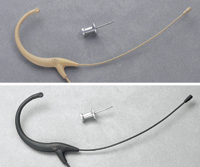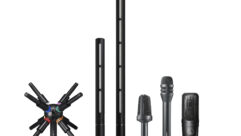

Audio-Technica BP896cW and BP892cW Review
Nov 9, 2009 12:00 PM,
By John McJunkin
Two tiny mics that effectively capture the entire frequency spectrum.
Audio-Technica BP892cW
Lavalier and headworn mics are central, important staples in the toolkits of contractors and integrators the world over, so any advancement in the quality of these important tools is greeted with pleasure by the professionals who use them. These mics can be used nearly interchangeably, so it made sense to evaluate one of each from Audio-Technica‘s latest array of offerings. While reductions in the size of microphones have slowed in recent years, the audio quality they exhibit continues to increase, and that is precisely what Audio-Technica (A-T) has achieved with these new mics. I evaluated these mics by applying them in real-world situations, and I discovered that they are very worthy of consideration. This is no surprise, considering that Audio-Technica has a reputation for constant new development and improvement.
I evaluated the BP896cW MicroPoint lavalier mic and BP892cW Microset headworn mic, along with Audio-Technica’s Artist Elite AEW-R4100 receiver and AEW-T1000 UniPak transmitter. The BP896cW MicroPoint is Audio-Technica’s latest lavalier offering, and its smallest yet—keeping pace with the state of the art in lav mics. The actual microphone element is 0.43in. long and 0.1in. in diameter. This is a truly tiny microphone, so I was very curious to see if A-T could pull off quality transduction with such a small package. The two-conductor shielded cable that connects it to either a power module or wireless transmitter is 1.4 meters long. More importantly, it is only 1.6mm in diameter. The mic’s cable is available with A-T’s 4-pin connector for use with UniPak wireless systems; a Lemo connector or locking 3.5mm connector for use with Sennheiser wireless systems; a TA4F-type connector for use with Shure wireless systems; a TA5F-type connector for use with Lectrosonics wireless systems; or an unterminated version so contractors can make the determination themselves. All of these versions are available in both black and beige.
The lav mic is a fixed-charge back-plate, permanently polarized condenser with an omnidirectional pattern. Frequency response is published as 20Hz to 20kHz, with a UniSteep high-pass filter available in the wired version. This filter has a corner frequency of 80Hz and slope of 18dB/octave, and it is used to reduce popping from plosives, wind noise, and low-frequency ambience. The frequency response is quite flat, with the notable exception of a smooth bulge from 10kHz to 20kHz, centered at approximately 15kHz and with a maximum increase in sensitivity of approximately 3dB. This is a very welcome nonlinearity in that it contributes nicely (and subtly) to the air captured by the mic. Impedance is rated at 250Ω, and the mic is rated for a maximum input sound level of 135dB SPL, which is plenty for a lavalier mic. The mic’s output signal is quiet with its signal-to-noise ratio published as 63dB. It’s quite forgiving in terms of its phantom-power requirement, operating on a range from 11V to 52V at 2mA, so if a contractor wishes to provide phantom power, tolerance is not particularly critical. For wired applications, the mic ships with an AT8539 power module to provide the required phantom power.
The mic also ships with an array of accessories, including two AT8157 windscreens; six element covers (two of each in white, beige, and black); a viper clip base; a clothing clip base; three black single mic holders; two black double mic holders; a carrying case; and a belt clip for the wired version. Nearly every conceivable placement scheme can be accomplished with the included clips.
The BP892cW is a headworn mic featuring the same condenser element as the BP896cW. It is literally the same element, so all technical specifications are identical. This mic comprises a simple boom suspended by an earpiece. The boom is 3.87in. long and 0.04in. in diameter. It almost appears frail considering the slender boom, but the metal from which it is made is substantial yet easily molded to get the mic close to the wearer’s mouth. A moisture-blocking ring is placed on the boom. Although getting the mic element in a good position is easy, it’s not particularly critical because the element is omnidirectional, and as long as it’s placed within a couple of inches of the user’s mouth, a clear, highly intelligible signal is captured. I have been a user of older A-T mics (both lavalier and headworn), and I was pleasantly surprised with the leap in quality that this mic delivered.
1
Audio-Technica BP896cW and BP892cW Review
Nov 9, 2009 12:00 PM,
By John McJunkin
Two tiny mics that effectively capture the entire frequency spectrum.

Audio-Technica BP896cW
I do have a complaint about the earpiece, however. A-T touts in its literature an “ultra-secure” fit. Perhaps it just takes more sculpting of the flexible earpiece or perhaps I just have extra-large ears. Either way, I was never able to get the mic solidly secure so that the boom did not swing, nor could the other people I asked to wear the mic. Fortunately, because the omnidirectional pattern is very forgiving, it was not a huge issue.
Related Links

Wireless In-ear Monitoring Systems
In-ear monitoring (IEM) is at the apex of a series of tech advances that have led up to the ability of stage performers having their own customized monitoring environment in a live music situation….

Conferencing is a very demanding environment for microphones, especially those held in large meeting spaces with high-level sound-reinforcement systems….

Installation Spotlight: Teach and Post
When De Anza College in Cupertino, Calif., decided to create a classroom for environmental science courses that allowed faculty members to record their lectures for students to view on-demand at home, …
The AEW-4110D wireless system I evaluated with these mics is not the central focus of the review, but it should be mentioned in some detail. It is composed of an AEW-T1000 UniPak transmitter and AEW-R4100 receiver. The system operates on 200 selectable UHF frequencies in two bands (541.500MHz to 566.375MHz and 655.500MHz to 680.375MHz). It features A-T’s IntelliScan, which automatically finds and sets the best available frequencies on all linked receivers. The system also features Dual Compander circuitry to process low and high frequencies separately. Another nice touch is the ability to enter the names of performers or speakers into the transmitters and receivers for easy reference.
I test-drove these mics with several people, getting an array of male and female voices. With a minimum of equalization, I was able to capture an excellent, clear signal. Noise was virtually nonexistent, and there was no audible distortion. The key word here is “intelligibility,” and these mics both have it in spades. Due to the omnidirectional pickup pattern and sensitivity of both mics throughout the spectrum, a bit more monitor wringing was necessary, but it was very well worth the effort. My initial concern over the capacity for such tiny mics to capture the entire frequency spectrum effectively was quickly allayed once I heard them. These are great mics, and they should be on the short list if you need a high-quality lav or headworn mic.
John McJunkin is the principal of Avalon Podcasting in Chandler, Ariz. He has consulted in the development of studios and installations, and he provides high-quality podcast and new-media production services.
Product Summary
- Company: Audio-Technica
www.audio-technica.com - Product: BP896cW MicroPoint lavalier mic and BP892cW Microset headworn mic
- Pros: High-quality, high-fidelity mics.
- Cons: Headworn mic’s earpiece does not grasp ear effectively for some users.
- Applications: Stage, broadcast, lecture, or house of worship.
- Price: $319 (BP896cW); $419 (BP892cW)
Specifications
Both microphones
- Polar pattern: Omnidirectional
- Frequency response: 20Hz to 20kHz
- Low-frequency roll-off: 80Hz, 18dB/octave (wired only)
- Open-circuit sensitivity: -49dB (3.5mV) re 1V at 1Pa
- Impedance: 250Ω (wired only)
- Maximum input sound level: 135dB SPL, 1kHz at 3% THD
- Dynamic range (typical): 104dB, 1kHz @ max SPL (wired only)
- Signal-to-noise ratio: 63dB, 1kHz at 1Pa
- Phantom power requirements: 11V to 52V DC, 2mA typical (wired only)
- Current consumption: 0.1 mA typical at 5V (wireless only)
- Voltage range: 2.5V to 11V (wireless only)
BP896cW
- Weight (mic): 0.005oz.
- Weight (power module): 3oz. (wired only)
- Dimensions (mic): 0.43in. long, 0.1in. diameter
- Dimensions (power module): 3.84in. long, 0.74in. diameter (wired only)
- Output connector (power module): Integral 3-pin XLRM-type
- Cable: 1.4 meters (55in.) long (permanently attached to microphone), 0.06in. diameter, two-conductor shielded cable with locking 4-pin connector (wired only)
BP892cW
- Weight (mic, boom, and earpiece): 1oz.
- Dimensions (mic): 0.32in. long, 0.10in. diameter
- Dimensions (boom): 3.87in. long, 0.04in. diameter
- Output connector (power module): Integral 3-pin XLRM-type
- Cable: 1.4 meters (55in.), unterminated
2









